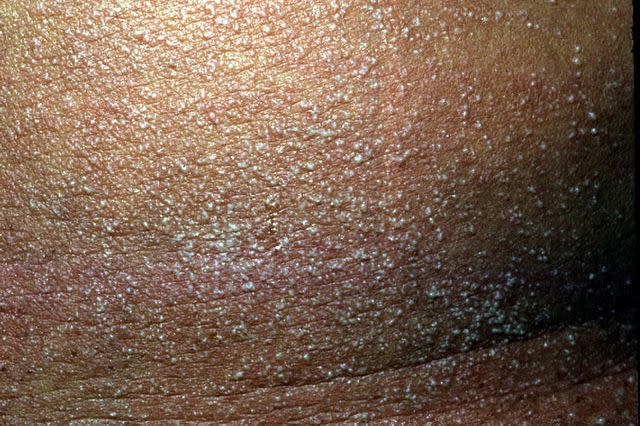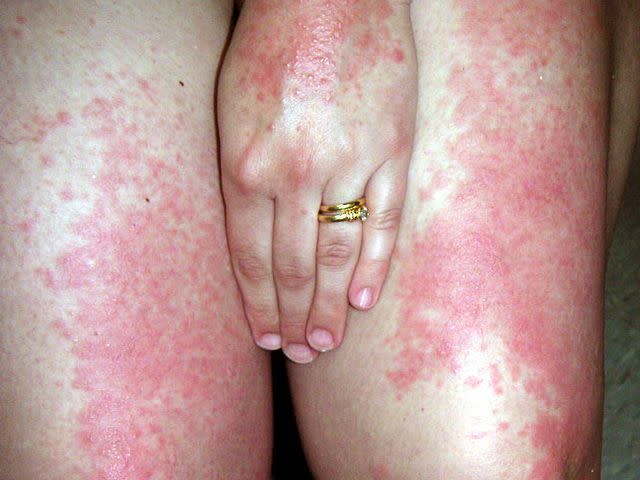Heat Rash vs. Sun Poisoning: What’s the Difference?
Medically reviewed by William Truswell, MD
Spending time in the sunshine is an excellent way to boost your mood and vitamin D levels, but too much sun exposure harms your skin and can lead to heat-related illnesses, like heat rash and sun poisoning (severe sunburn).
While heat rash and sun poisoning share similarities, they have distinct causes and require different treatments.
This article discusses the differences between heat rash and sun poisoning, what causes these common skin rashes, and how to tell the difference. It also covers treatment and prevention.

Pollyana Ventura / Getty Images
Heat Rash vs. Sun Poisoning: How to Tell the Difference
While heat rash and sun poisoning are both heat—and sun-related skin problems, they have distinct causes and characteristics. Knowing the difference can help you identify which you have and determine the most appropriate treatment and prevention methods.
| Heat Rash | Sun Poisoning |
Appearance | Small red or purple bumps or pimple-like blisters | Red, blistering, and peeling skin |
Location | Develops in areas prone to friction and collecting sweat, such as the neck, chest, groin, back, and armpits | Affects any sun-exposed skin area (e.g., ears, face, shoulders, legs) |
Onset | Develops within a few hours after sweating in hot and humid conditions | Appears within several hours up to 24 hours after prolonged sun exposure |
Other Symptoms | Itchiness or stinging sensations | Intense pain, fever, nausea, and chills |
What Causes a Heat Rash?

Reproduced with permission from ©DermNet www.dermnetnz.org 2023
Heat rash, or “prickly heat,” looks like a cluster of tiny red or purple bumps or pimple-like blisters. Normally, sweat flows through sweat ducts onto the skin’s surface, where it evaporates to keep your body cool during hot weather or when your body temperature rises (e.g., during exercise).
Sweating more than usual can block your sweat ducts. Heat rash develops when your sweat glands are clogged, trapping sweat under your skin. Anyone can develop heat rash, though it is most common in infants and young children with underdeveloped sweat glands.
Hot and Humid Weather
Sweating is your body's way of regulating your temperature in hot, humid weather. Excessive sweating can lead to clogged sweat ducts, trapping sweat beneath the skin’s surface. The trapped sweat seeps into nearby tissues, leading to small pockets of swelling and the formation of tiny blisters or bumps (heat rash).
People living in cooler climates are more likely to develop heat rash when visiting a location with warm, humid weather. Sudden temperature changes (e.g., cool to hot and humid) can also increase the risk of heat rash.
Physical Activity
Physical activities, such as exercise or strenuous labor, cause you to sweat more than usual. When sweat accumulates and becomes trapped under the skin, heat rash can develop in body areas such as the neck, back, chest, and inner elbows. Repetitive movements during physical activity also create friction between skin surfaces or the skin and clothing, contributing to the development of heat rash.
Synthetic or Tight Clothing
Wearing tight clothing or clothes made from synthetic fabrics increases the risk of heat rash, especially in hotter weather. Synthetic fabrics (e.g., polyester, nylon) are generally less breathable than natural fibers like cotton and can restrict airflow, trapping heat and moisture against the skin. This can clog sweat ducts and lead to heat rash.
Wearing tight-fitting clothes increases sweating and creates friction between your skin and clothing. The combination of friction, increased sweating, and inadequate airflow for sweat to evaporate increases the likelihood of developing a heat rash.
Overheating
Anything that causes your body to overheat, such as a fever, wearing too many layers of clothing, or sleeping under thick blankets, can increase sweat production, block sweat ducts, and trigger heat rash.
Sweating is your body’s natural cooling mechanism, but if sweat cannot evaporate efficiently due to humid conditions or prolonged overheating, moisture and heat accumulate on the skin’s surface, leading to heat rash.
Heat Rash Symptoms and Treatment
Heat rash symptoms typically develop within minutes to hours after spending time in hot, humid weather or sweating. It is most common to develop heat rash in areas where there is friction with clothing or skin folds, such as the:
Armpits
Elbow creases
Neck
Under the breasts
When heat rash symptoms develop, they can include:
Clusters of small bumps that appear purple on darker skin tones and red on lighter skin tones
Itching
Stinging sensations
Heat rash treatment involves limiting exposure to heat and humidity and keeping your skin cool and dry. Most cases of heat rash clear up within three days with self-care measures, such as:
Applying calamine lotion to soothe an itchy rash
Applying cool compresses (e.g., damp, wet washcloth or ice pack covered in a towel) to the affected area
Avoiding moisturizers or lotions on the affected area to prevent further plugging of sweat ducts
Limiting strenuous activities
Staying hydrated
Staying in cool, air-conditioned spaces or using a fan to circulate air
Taking a cool shower or bath
Wearing loose-fitting, breathable clothing made from natural fabrics like cotton
What Causes Sun Poisoning?

Reproduced with permission from © DermNet dermnetnz.org 2023.
Sun poisoning is a severe sunburn that happens when the sun’s ultraviolet (UV) rays damage your skin cells, triggering inflammation that leads to symptoms such as:
Chills
Fever
Nausea
Pain or tenderness
Rash (e.g., itchy bumps)
Redness
Skin peeling
People with lighter skin are more likely to develop sun poisoning than people with darker skin because they have less melanin. Melanin is a brown pigment your body makes to block harmful UV rays and protect your skin.
Sun poisoning occurs when exposure to the sun’s UV rays exceeds melanin’s ability to protect your skin. Sun poisoning symptoms typically develop within a few hours and peak (are at their worst) between six and 48 hours after sun exposure.
How to Treat and Avoid Sun Poisoning
If you develop sun poisoning, the first thing to do is seek shade or stay indoors until your symptoms subside. In some cases, self-care measures may be enough to treat sun poisoning. Here’s how to treat sun poisoning at home:
Cool down your skin: Take a cool bath or shower or place cool, wet washcloths on the affected areas.
Consider pain relievers: Over-the-counter pain relievers like Advil or Motrin (ibuprofen) and Tylenol (acetaminophen) can relieve mild to moderate pain.
Hydrate: Sun poisoning draws fluids away from the rest of your body to hydrate the skin. Drinking plenty of water to replenish lost fluids can prevent dehydration.
Let blisters heal: Do not attempt to pop or scratch blisters that form on your sunburned skin. Breaking open a blister increases the risk of a bacterial skin infection.
Moisturize: Hydrate your skin with an aloe vera–based moisturizer or gel.
Use medicated cream: Apply over-the-counter hydrocortisone cream to the affected area to reduce inflammation and pain. Avoid using benzocaine or lidocaine on a sunburn, which can dehydrate the skin and worsen symptoms.
Wear loose clothing: To prevent skin irritation and worsening pain, opt for loose-fitting clothing made of natural fibers like cotton.
More severe sun poisoning requires prompt medical treatment. Depending on the severity of your symptoms, you may need treatment in a hospital to control pain and hydrate your body. Medical therapies for sun poisoning include:
Cool water soaks
Intravenous fluids to replenish lost fluids and electrolytes
Oral steroids to reduce inflammation
Prescription pain medications to alleviate discomfort
Taking proactive measures to protect your skin from the sun’s UV rays is the best way to avoid or prevent sun poisoning. This includes:
Apply a broad-spectrum sunscreen with a sun protection factor (SPF) of 15 or higher liberally and evenly to all exposed skin at least 20 minutes before going outdoors.
Reapply sunscreen every two hours and each time you sweat heavily or get out of the water (e.g., after swimming).
Seek shade (e.g., under trees, umbrellas), especially during hours of peak sun (10 a.m. to 4 p.m.).
Wear protective clothing, such as wide-brimmed hats, tight-weave fabrics, and sunglasses.
When to Contact a Healthcare Provider
While most cases of heat rash and sun poisoning are manageable with at-home treatments and self-care measures, certain symptoms warrant medical attention. If you suspect you or your child have heat rash, see a healthcare provider if the following apply:
The rash is severe or symptoms are worsening.
Symptoms do not improve with home treatments after four days.
You develop signs of infection, such as pus-filled blisters, fever, red streaks on the skin, swelling, or severe pain.
Severe sun poisoning requires medical attention and treatment. See a healthcare provider as soon as possible if you experience any of the following:
Confusion
Fainting
Fever and chills
Headache
Intense pain lasting 48 hours or more
Nausea or vomiting
Severe dehydration
Severe skin blistering
Sunburn on 15% or more of your body
Summary
Heat rash and sun poisoning are two common heat-related skin problems. Heat rash appears as tiny red or purple bumps from trapped sweat, usually in the neck, back, groin, or armpits. It develops within hours of sweating and clears up with simple measures like cool showers and wearing breathable clothing.
Sun poisoning can develop up to 24 hours after spending too much time in the sun. It may cause incredibly painful and red skin, blisters, fever, nausea, and chills. Treatment depends on the severity of symptoms and may include staying out of the sun, cool compresses, or in-hospital intravenous fluids in severe cases.
Talk to a healthcare provider if you are unsure if you have a heat rash, sun poisoning, or another heat-related illness or rash.
Read the original article on Verywell Health.

